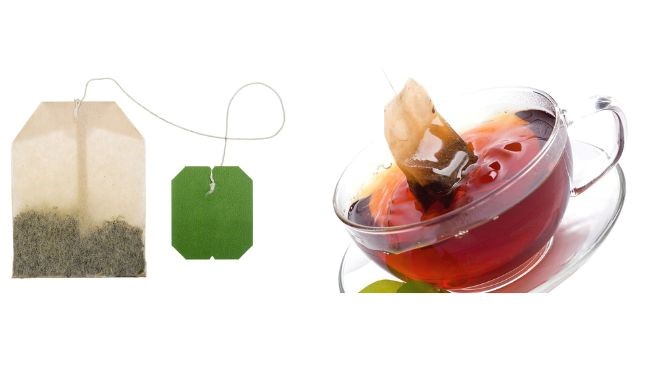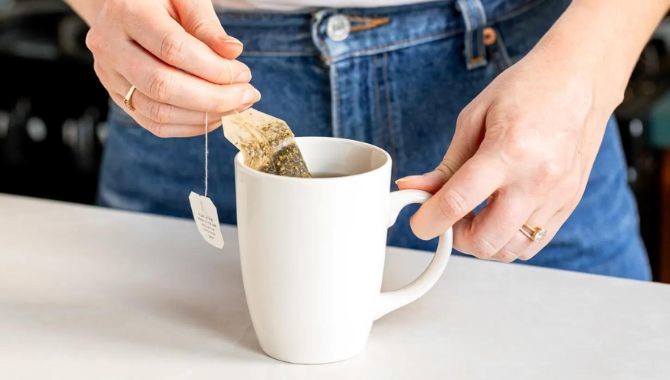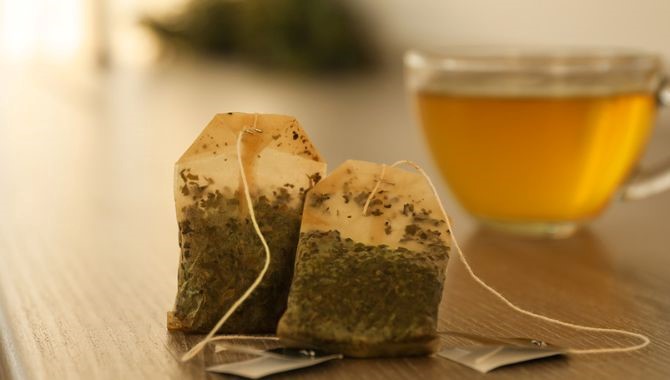Tea bags are small, permeable, sealed pockets that contain tea leaves which step when put in hot water thus releasing flavors.
The materials used in making tea bags vary and therefore can contain toxic substances.
Components of Tea Bag

Tea bags often hold dried tea leaves or herbs which infuse in hot water to release flavor. However, the bags are made of plastics, nylon, or bleached paper which are sealed by glue stapler or both.
These materials possess harmful chemicals that infuse into the tea thus affecting our health and eventually the planet when disposed of.
Tea bags often hold dried tea leaves or herbs which infuse in hot water to release flavor. However, the bags are made of plastics, nylon, or bleached paper which are sealed by glue or stapler or both.
These materials possess harmful chemicals that infuse into the tea thus affecting our health and eventually the planet when disposed of.
Elements that Make Tea Bags Harmful
Studies have shown that tea bags release about 11 billion micro-plastics and approximately 3.5 nano-plastics with every cup served. These chemicals are then consumed with the tea thus ending up in our body.
Over time, the chemical buildup in our bodies affects our health as well as the environment from the disposal.
Some of the harmful elements associated with tea bags include:
- Plastic compounds (Bisphenol A and polypropylene)
- Chlorine from bleaching material
- Nylon
- Metal compounds such as lead, uranium, nitrites, and mercury.
Risks Associated with Tea Bag Materials

There are several risks associated with harmful compounds that tea bag materials release. These risks can be categorized into health and environmental.
· Effects of Tea Bags on our Health
Plastic materials used in tea bags are mostly Bisphenol A and polypropylene. These plastic compounds are associated with adverse health risks such as cancer, nervous breakdown, endocrine and digestive problems.
Various studies have shown that these plastic compounds accumulate in the fatty tissues while tiny ones enter human cells.
The human body cannot absorb plastics, therefore, they end up accumulating in the system leading to various health issues.
Sealing materials such as glue or metal staplers are used to contain toxic substances such as nitrites, uranium, copper, lead, mercury, etc. Exposure to these metals may cause brain damage, kidney failure, and blood pressure, affecting the central nervous system among others.
· Effects of Tea Bags on the Environment
Nylon material is used in making tea bags because of its high-temperature tolerance as compared to plastic. It is, however, non-biodegradable making it last longer in the environment without decomposing or even the possibility of recycling.
Plastic materials as well as heavy metal compounds released from disposed tea bags do not decompose. Instead, they release the toxic substances into the soils, underground water, and oceans, polluting our ecosystem
Safer Options of Tea Bags
As we have seen, conventionally produced tea bags are not safe for humans due to the materials used in their production. You can still safely enjoy your tea by brewing loose tea leaves or using your tea bags.
· Loose Tea Leaves and Flowers Teas
Unlike tea bags, loose tea leaves are an easy and safer alternative for tea lovers who would like to avoid harmful materials. All you need is a tea strainer or infuser, tea leaves, and a non-toxic pot to brew your tea.
Secondly, loose leaves have proven to be more economical as they can produce more servings from a small quantity. This is because they are stronger and more flavorful than tea bags. After all, they can expand more during the brewing process.
Loose flower teas are also a good option when it comes to safe alternatives to tea bags. Flower teas are prepared by boiling in water and letting them sit for a few minutes before serving.
Several servings can be obtained by adding more water to the flower and boiling it over again.
· Silk Tea Pouches
Another option for safe tea option is to produce your resealable tea bags using silk material. Unlike other materials that are currently used in the mass production of tea bags, silk material is naturally occurring and is 100% biodegradable.
The resealable tea bags do not require glue or staples to close them up. Therefore, they are not so far different from loose tea.
How to Ensure Tea Bag Safety

The only way to ensure tea bag safety is to go for organic tea bags such as resealable silk pouches. Most tea bags in the market are made from plastic, nylon, or bleached paper. These materials leech potentially toxic substances that can cause harm to your health and the environment too.
How to know if your Tea Bags are Safe
While buying your favorite tea bags, check the material information on the packaging of the tea bags. Tea bags made from plastic, nylon, or bleached paper are not safe for you due to their toxins.
They also pose a challenge to the environment since these toxins can also be leached into the soil and water bodies.
We, therefore, recommend buying tea bags made from organic materials that do not release harmful substances such as silk tea bags.
Conclusion
Whereas tea bags provide convenience for tea lovers due to their simplicity of use, they pose a potential challenge as well. Material used for making tea bags is therefore important factor to consider before buying your favorite tea bags.
More Resources:
How many Times can you use Tea Bag – Source: JOCHAMP
Tea Bag – Source: WIKIPEDIA
Tea Bag Packing Machine – Source: JOCHAMP


